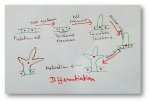Worksheet on How Plants make Food
Worksheet on how plants make food contains various types of questions on what makes the leaves green, veins of a leaf and photosynthesis in a leaf.
I. Match the column:
(i) Stomata (a) food factory of the plant
(ii) Leaf (b) through veins
(iii) Chlorophyll (c) tiny holes in the underside of a leaf
(iv) Starch (d) green substance that traps sunlight
(v) Water (e) stored food in plants
II. Fill in the
blanks:
(i) Photosynthesis is the process in which a plant makes _________ with the help of _________ from the soil and __________________ from the air.
(ii) The gas _________ is given out during this process, which we use for breathing.
III. Answer the following questions:
(i) Why are leaves green in color?
(ii) Why is sunlight so important for a plant to make its food?
(iii) Without chlorophyll food cannot be made. Why?
(iv) Where do plants store their extra food?
(v) How is the food prepared by plants used?
Check the answers of the worksheet on how plants make food:
Answers:
I. (i) Stomata (c) tiny holes in the underside of a leaf
(ii) Leaf (a) food factory of the plant
(iii) Chlorophyll (d) green substance that traps sunlight
(iv) Starch (e) stored food in plants
(v) Water (b) through veins
II. (i) food, water, carbon dioxide
(ii) oxygen
III. (i) Leaves are green in color because they have chlorophyll.
(ii) Sunlight is important because they provide the energy needed for a plant to make its food.
(iii) Without chlorophyll food cannot be made because chlorophyll traps the sunlight.
(iv) Plants store their extra food as starch in roots, stems, leaves, fruits and seeds.
(v) The food prepared by plants is used for growth; making flowers, fruits and seeds; repairing damage.
From Worksheet on How Plants make Food to HOME PAGE
Recent Articles
-
Differentiation, Dedifferentiation and Redifferentiation | Definition
Apr 21, 25 01:16 PM
Cells from the root apical meristem and shoot apical meristem the camera that differentiate , mature to perform different functions. This process by which the cells undergo different major structural… -
Explain about Growth in Plants |Definition of Growth & Differentiation
Feb 27, 25 02:07 PM
Growth is a permanent increase in length or volume of an organism that brought upon by an increase in its dimensions due to synthesis of new protoplasmic material. -
Definition of Respiratory Quotient | calculation | Application | Plant
Dec 02, 24 12:09 AM
Definition of respiration quotient- the ratio of the carbon-dioxide evolved to that of the oxygen consumed by a cell, tissue, plants or animals in a given time is called respiratory quotient. It is us… -
Amphibolic Pathway | Definition | Examples | Pentose Phosphate Pathway
Jun 06, 24 10:40 AM
Definition of amphibolic pathway- Amphibolic pathway is a biochemical pathway where anabolism and catabolism are both combined together. Examples of amphibolic pathway- there are different biochemical… -
Respiratory Balance Sheet | TCA Cycle | ATP Consumption Process
Feb 18, 24 01:56 PM
The major component that produced during the photosynthesis is Glucose which is further metabolised by the different metabolic pathways like glycolysis, Krebs cycle, TCA cycle and produces energy whic…




New! Comments
Have your say about what you just read! Leave me a comment in the box below.